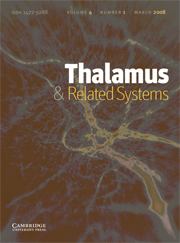Article contents
Modulation of neurons in the paraventricular thalamic nucleus by α2 adrenoceptor agonists: evidence for physiological and morphological heterogeneity
Published online by Cambridge University Press: 11 June 2007
Abstract
The paraventricular thalamic nucleus (PVT) receives dense noradrenergic input, but little is known about α2 adrenoceptors (ARs) in this nucleus. We have investigated effects of the agonist α-methyl-norepinephrine (m-NE) on PVT neurons in vitro. Based on their physiological and morphological characteristics, three distinct classes of PVT neurons have been identified. The first class exhibits membrane hyperpolarization on stimulation with m-NE (0.05–25 µM). This hyperpolarizing effect is observed in the presence of tetrodotoxin (TTX; 0.5–1 µM), blocked by yohimbine (1 µM) and mimicked by clonidine (10 µM), which indicates that it is mediated by postsynaptic α2 ARs. Further experiments indicate that it is mediated through an increase in G protein-coupled K+ conductance. In a second class of neurons, m-NE (0.05–25 µM) induces a slow membrane depolarization that is mimicked by phenylephrine (5 µM) and blocked by prazosin (75 nM), which indicates the involvement of α1 ARs. The third class of neurons is insensitive to m-NE (5–25 µM), and has a lower input resistance and a larger dendritic tree compared to the two other classes. The three types of neurons differ in their resting properties, and their firing patterns are changed by m-NE. These findings indicate anatomical and functional specialization of PVT neurons.
Information
- Type
- Research Article
- Information
- Copyright
- © 2007 Cambridge University Press
- 3
- Cited by

